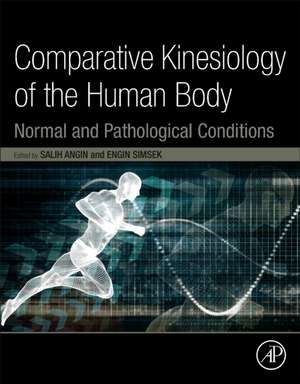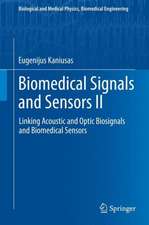Comparative Kinesiology of the Human Body: Normal and Pathological Conditions
Editat de Salih Angin, Ibrahim Simseken Limba Engleză Paperback – 19 mar 2020
This book is the perfect reference for researchers in kinesiology, but it is also ideal for clinicians and students involved in rehabilitation practice.
- Includes in-depth coverage of the mechanical behavior of the embryo as one of the major determinants of human movement throughout the lifecycle
- Provides a comparison of human movement between normal and pathological conditions
- Addresses each body region in functional and dysfunctional kinesiological terms
Preț: 847.76 lei
Preț vechi: 1127.36 lei
-25% Nou
Puncte Express: 1272
Preț estimativ în valută:
162.24€ • 176.17$ • 136.28£
162.24€ • 176.17$ • 136.28£
Carte tipărită la comandă
Livrare economică 15-29 aprilie
Preluare comenzi: 021 569.72.76
Specificații
ISBN-13: 9780128121627
ISBN-10: 0128121629
Pagini: 576
Dimensiuni: 216 x 276 mm
Editura: ELSEVIER SCIENCE
ISBN-10: 0128121629
Pagini: 576
Dimensiuni: 216 x 276 mm
Editura: ELSEVIER SCIENCE
Public țintă
Researchers of kinesiology as well as clinicians and students involved in rehabilitation practice; this may include exercise physiologists, physical therapists, occupational therapists, prosthetics and orthotics specialists, podiatric specialists, athletic trainers, and sports medicine physicians. Secondary: Biomedical engineers who design equipment for transportation, rehabilitation clinics and aiding daily living activities.Cuprins
PART 1: HISTORY AND BASICS OF KINESIOLOGY
1. Past, Present and Future of Kinesiology
2. Principles of Kinesiology
3. Fundamentals of Human movement, Its Control and Energetics
4. Architecture of Human Joints and their Movement
PART 2: TISSUES
5. Morphogenesis and Biomechanics of the Embryo and Foetus
6. Architecture of Bone Tissue and its Adaptation to Pathological Conditions
7. Architecture of Cartilage Tissue and its Adaptation to Pathological Conditions
8. Architecture of Muscle Tissue and its Adaptation to Pathological Conditions
9. Architecture of Tendon and Ligament and their Adaptation to Pathological Conditions
10. Architecture of Fascia and its Adaptation to Pathological Conditions
PART 3: UPPER EXTREMITY
11. Kinesiology of the Shoulder Complex
12. Kinesiology of the Elbow Complex
13. Kinesiology of the Wrist and Hand
PART 4: TRUNK AND PELVIS
14. Kinesiology of the Temporomandibular Joint
15. Kinesiology of the Cervical Vertebral column
16. Kinesiology of the Thoracic Vertebral Column
17. Kinesiology of the Lumbar Vertebral Column
18. Kinesiology of the Pelvis
PART 5: CARDIORESPIRATORY SYSTEM
19. Kinesiology of Respiration
20. Biomechanics of Circulation
PART 6: LOWER EXTREMITY
21. Kinesiology of the Hip
22. Kinesiology of the Knee
23. Kinesiology of the Ankle and Foot Complex
PART 7: SENSORY-MOTOR INTEGRATION AND PERFORMANCE
24. Motor Control and Sensory-Motor Integration of Human Movement
25. Motor Learning
26. Balance and Postural Control
PART 8: LOCOMOTION
27. Effect of Weightlessness on Human Body
28. Evolution of Bipedalism
29. Kinesiology of Human Gait
30. Biomechanical Principles of the Exercise Design
1. Past, Present and Future of Kinesiology
2. Principles of Kinesiology
3. Fundamentals of Human movement, Its Control and Energetics
4. Architecture of Human Joints and their Movement
PART 2: TISSUES
5. Morphogenesis and Biomechanics of the Embryo and Foetus
6. Architecture of Bone Tissue and its Adaptation to Pathological Conditions
7. Architecture of Cartilage Tissue and its Adaptation to Pathological Conditions
8. Architecture of Muscle Tissue and its Adaptation to Pathological Conditions
9. Architecture of Tendon and Ligament and their Adaptation to Pathological Conditions
10. Architecture of Fascia and its Adaptation to Pathological Conditions
PART 3: UPPER EXTREMITY
11. Kinesiology of the Shoulder Complex
12. Kinesiology of the Elbow Complex
13. Kinesiology of the Wrist and Hand
PART 4: TRUNK AND PELVIS
14. Kinesiology of the Temporomandibular Joint
15. Kinesiology of the Cervical Vertebral column
16. Kinesiology of the Thoracic Vertebral Column
17. Kinesiology of the Lumbar Vertebral Column
18. Kinesiology of the Pelvis
PART 5: CARDIORESPIRATORY SYSTEM
19. Kinesiology of Respiration
20. Biomechanics of Circulation
PART 6: LOWER EXTREMITY
21. Kinesiology of the Hip
22. Kinesiology of the Knee
23. Kinesiology of the Ankle and Foot Complex
PART 7: SENSORY-MOTOR INTEGRATION AND PERFORMANCE
24. Motor Control and Sensory-Motor Integration of Human Movement
25. Motor Learning
26. Balance and Postural Control
PART 8: LOCOMOTION
27. Effect of Weightlessness on Human Body
28. Evolution of Bipedalism
29. Kinesiology of Human Gait
30. Biomechanical Principles of the Exercise Design

















